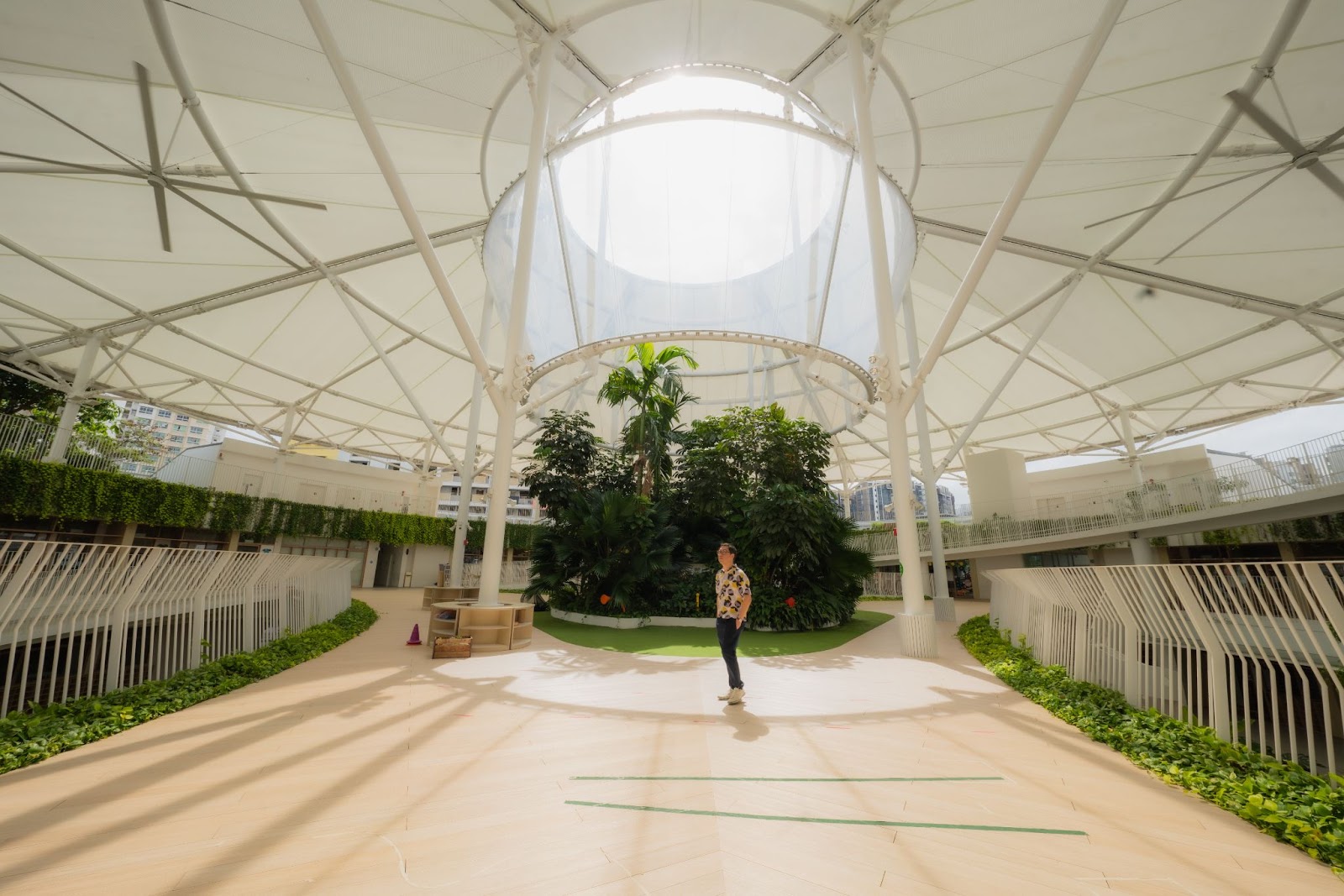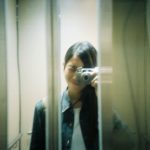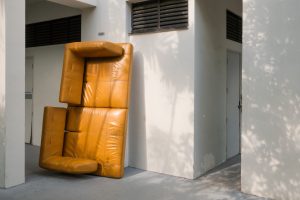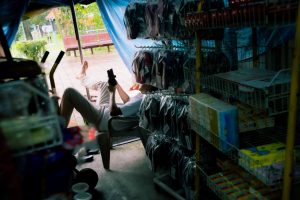In the ‘Future Communities’ series, RICE explores how architecture and social design shape how Singaporeans live, learn, work and play. We take a look at 3 projects that have received the nation’s highest design accolade: the President*s Design Award.
After checking out how a 21st-century kampung looks like in Admiralty, we wander to Punggol to examine an unconventional preschool.
All images by Nicky Loh for RICE Media.
If you’ve ever been in the vicinity of Punggol, chances are you might have spotted this building from afar. UFO this is not, but it very well could be with its one-of-a-kind dome-like exterior and features.
Not only is this the country’s largest Early Years Centre (EYC), it’s also one that’s been awarded Singapore’s highest design accolade — the President*s Design Award — in 2020. At full capacity, this three-storey preschool even holds up to 1,000 children at once.

There I was, on a bright Saturday afternoon, embarking on a tour around this very building. The assignment, as far as I knew, was to uncover the unique design aspects that could portend the future of preschools.
Unlike many other PAP Community Foundation (PCF) preschools across the island, this particular one isn’t located in your traditional void deck. It’s right smack on a large empty field instead, with blocks of BTOs and HDBs in its midst.
It’s been two decades or so since I’ve stepped foot in a preschool (or in my case, nursery). There’s just something oddly exciting about getting in touch with one’s inner child again.
It’s Not All About the Books
A well-planned preschool curriculum sets children on a strong foundational start, considering that these are their formative years — a time when their brains are at their spongiest.
But there seems to be one aspect that’s often missing in the conversation: the physical learning space itself.

We enter the school, strolling under what feels like a private tropical rainforest. It’s 2PM; the afternoon sun shines brightly from above. The open(ish) concept allows for excellent ventilation, effectively cooling us down despite our face masks.
It’s a weekend too, so no children around on campus that day. The air’s clear and calm, unlike the boisterous energy you’d typically expect in a preschool. Yet it wasn’t at all difficult to picture kids having their time of life here on a regular day.
Every speck of space is sprinkled with their presence — children’s art plaster classroom walls, greenery strategically placed in every nook and cranny. There’s something everywhere meant to seize a child’s imagination.

Along with me on the tour are Gilbert, PCF’s Operations Manager, and Tzu Yin, Founding Partner and Managing Director from LAUD Architects — the mastermind behind this preschool’s unique design.
“Hear the sound of those birds?” Gilbert whispers as we turn to listen to the melodious chirping coming from above.
“Being in an outdoor environment like this, teachers get to use natural elements as materials to keep students interested in their learning. Birds don’t only exist in books.”
Almost immediately, I notice recurring motifs within the space too — shapes like circles as well as the use of trees and wood, which are largely inspired by Tzu Yin’s childhood memories.
He’s 49-year-old this year but remembers his childhood vividly. Back then, he’d run around HDB blocks in circles and play under the rain. Those carefree days fostered a genuine love for nature, and it’s a theme he deliberately chose to replicate.
In gaining touch-screen devices, today’s children have fundamentally lost touch with nature. The way Tzu Yin sees it, design can help replicate the unstructured way of learning that our parents and grandparents might have had.
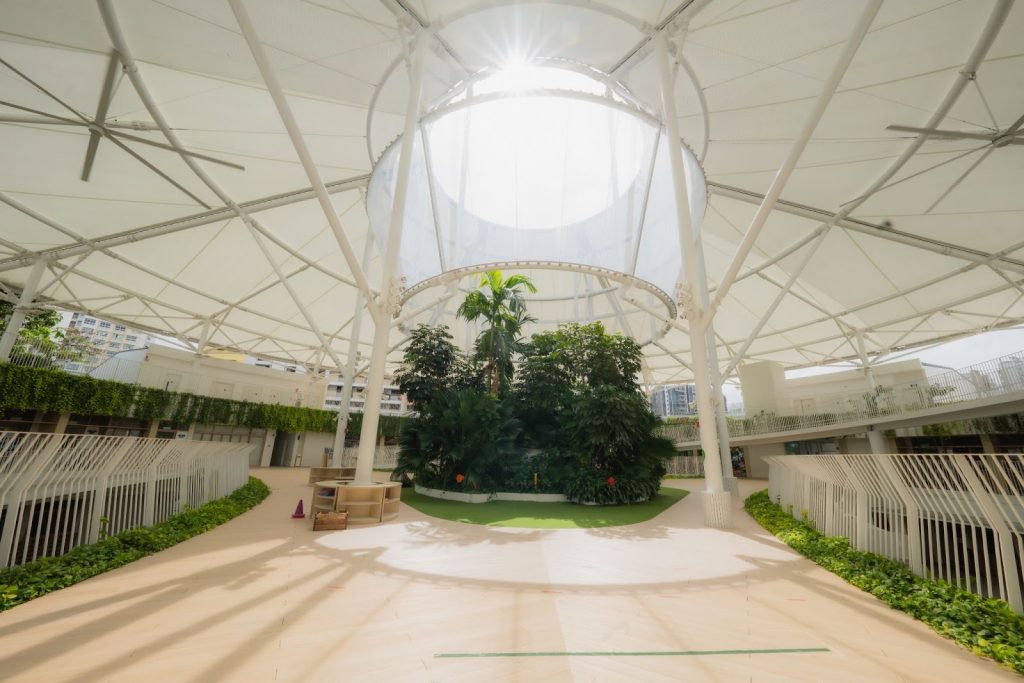
At the heart of this circular building sits an overhanging roof canopy, a symbol of shelter and protection. This is also where rainwater would fall on wet weather days; it’s meant to instil the same sense of wonder and appreciation that Tzu Yin had as a kid.
“The goal was to immerse kids in a natural environment. Having an exploratory play area helps to exude a warm and welcoming school ambience where they can always feel at home,” he explains.
Looking around, I assumed that the fees in such a modernised well-designed school would be on the higher end. Gilbert shares that it’s a common assumption far from the truth.
“Unlike what many people think, the school fees here are actually the same as other regular PCF preschools,” he says. “For some parents who are able to get subsidies, it might even be cheaper.”
Adults Were Once Kids Too
“If only I had that slide in my preschool. Looks super fun,” my colleague, Larissa, exclaims at one point.
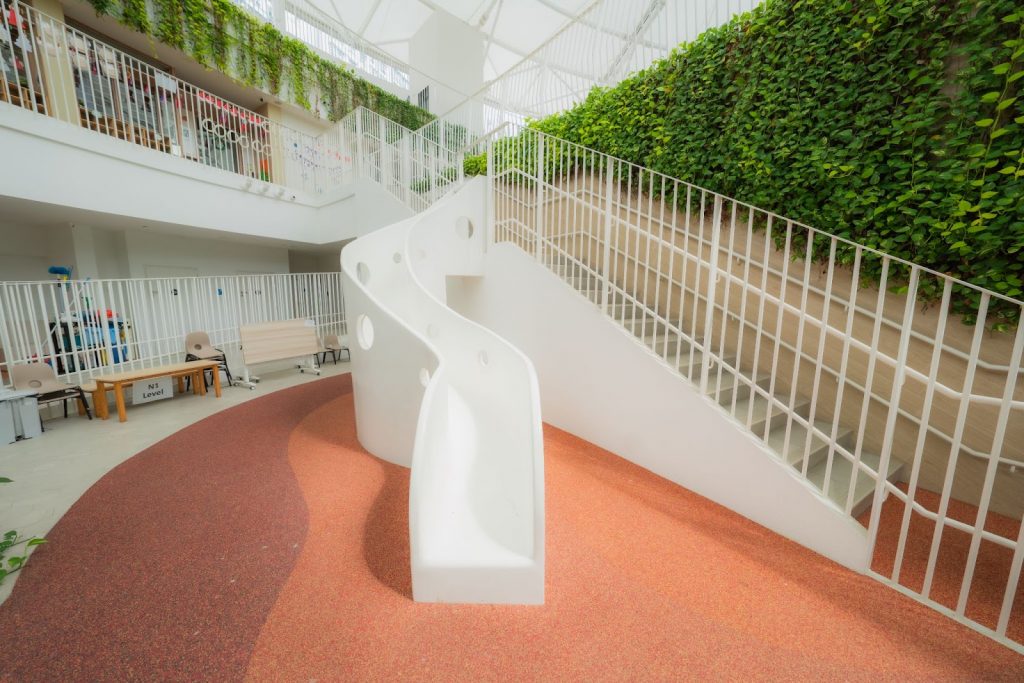
I turn to see a tiny slide located outside one of the classrooms, a short distance away from the main entrance.
Tzu Yin chimes in: “Oh yes, I decided to add this here because it helps keep the kids occupied especially when they’re waiting for their parents to pick them up.”
Genius! That makes one less kid who’d otherwise be bawling from potential homesickness. Ma and Pa can wait so long as the kid’s still having fun. Distraction isn’t necessarily a bad thing after all.
If one slide could make two twenty-odd-year-olds excited, imagine the joy of a toddler.
According to Gilbert, there have been several occasions where kids lost track of time whilst playing on this very slide. It’s made life easier for busy parents who may be running late after work to fetch their kids.
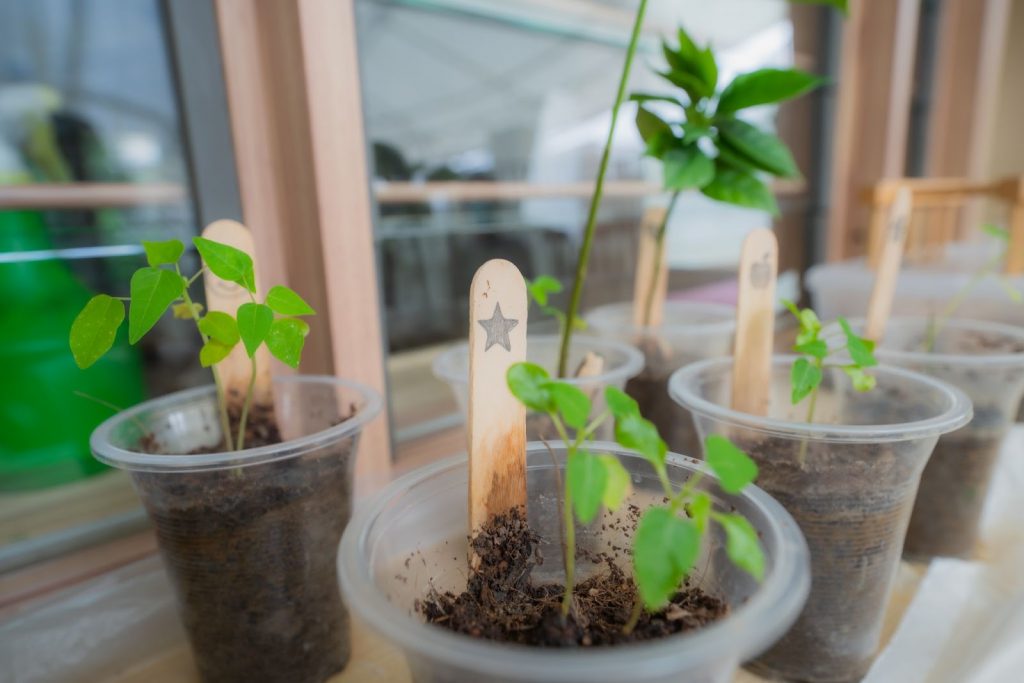
My memories of preschool (or nursery) are incredibly hazy, but I remember it as a time when I was able to confidently be myself. It was where I had my very first birthday party in school (shoutout to that OG Teletubbies cake); it was where I learnt to share toys with others; it was where I fought and forgave.
Essentially, preschool is a time when we pick up essential values and social skills. Sharing and forgiveness, though simple, can be incredibly difficult for many grown-ups. It’s unfortunate that many of these things are lost as we transition into adulthood.
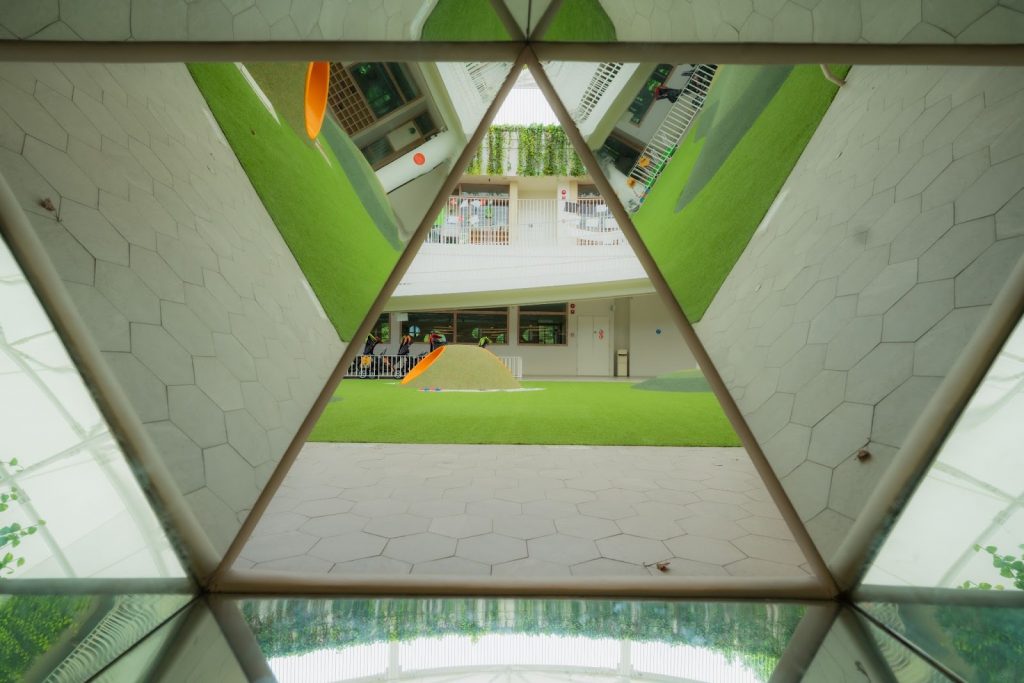
Unlike the preschool that we were exploring, my old preschool was stifling in comparison. Classes were arranged in a linear fashion along a void deck, much like in primary and secondary school; which meant that the majority of us kept to ourselves and barely made the effort to mingle.
While one’s predisposition of shyness might be a factor, it’s hard to deny the impact of common shared spaces as a way to instil social skills and behaviours.
One memory remains crystal clear: Even on the rare days when I enjoyed school, I’d still dread returning the next day. School was strictly for learning (aka dull), while play was a separate thing altogether. I never saw them as things that could co-exist.
Conversely, this experiential learning hub in Punggol is a myriad of play areas — there are classrooms, playgrounds; an endless corridor with a spectrum of colours; even a herb and vegetable farm with animal-inspired signages all packed within one circular building.
Learning and playing are not two separate entities, and it’s easy to see how these come together to help spark the little ones’ imaginations.
Impacting Tiny Lives Through Tiny Details
Unlike the modular, plain classrooms of my past, it’s obvious that every bit of detail has been thoroughly thought through at this preschool. Depending on the age group (2 months to 4-years-old), play areas have been designed differently in terms of scale and texture.
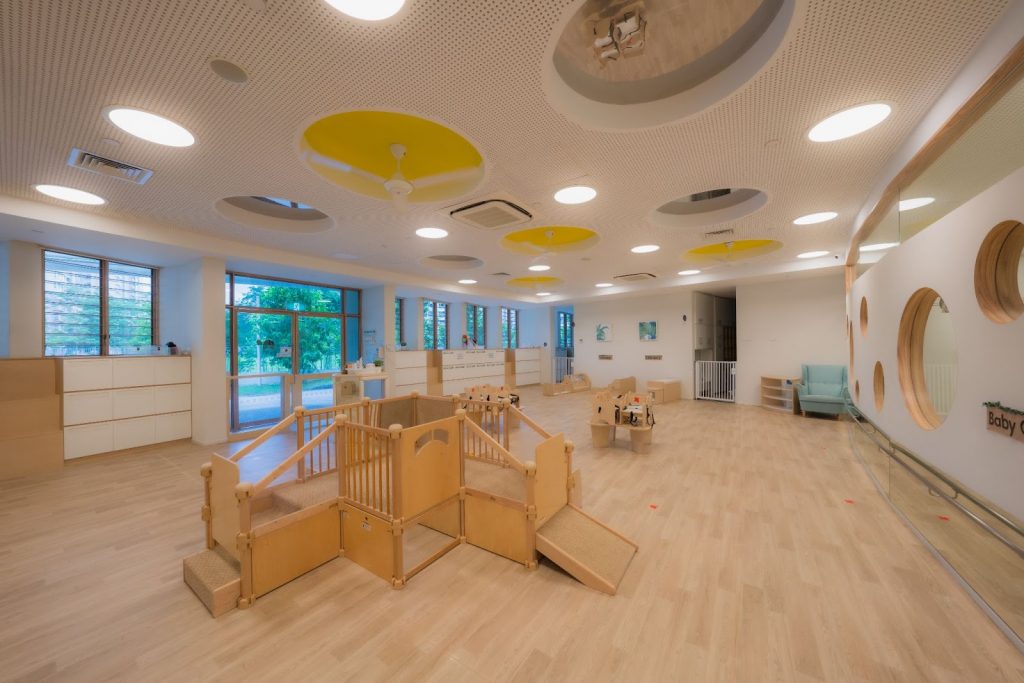
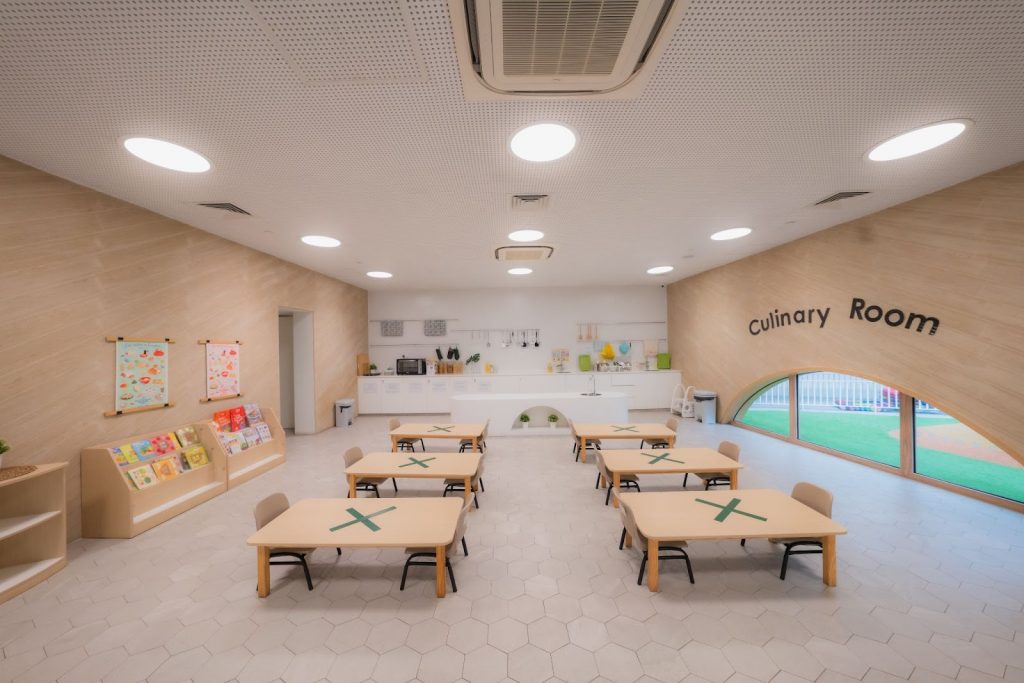
Just to name a few: Handlebars and mirrors that match the height of infants, a culinary and music room, even balancing beams and gentle slopes for toddlers to crawl freely.
Tzu Yin points out that there are multiple exit points located conveniently around the circular building too. It seems like the kids wouldn’t be faced with a wall of adults every time they are dismissed.
“Having more exit doors helps to prevent a large volume of people congregating at the main entrance,” Tzu Yin says. It has been especially useful in times like these to keep children safe during a pandemic.

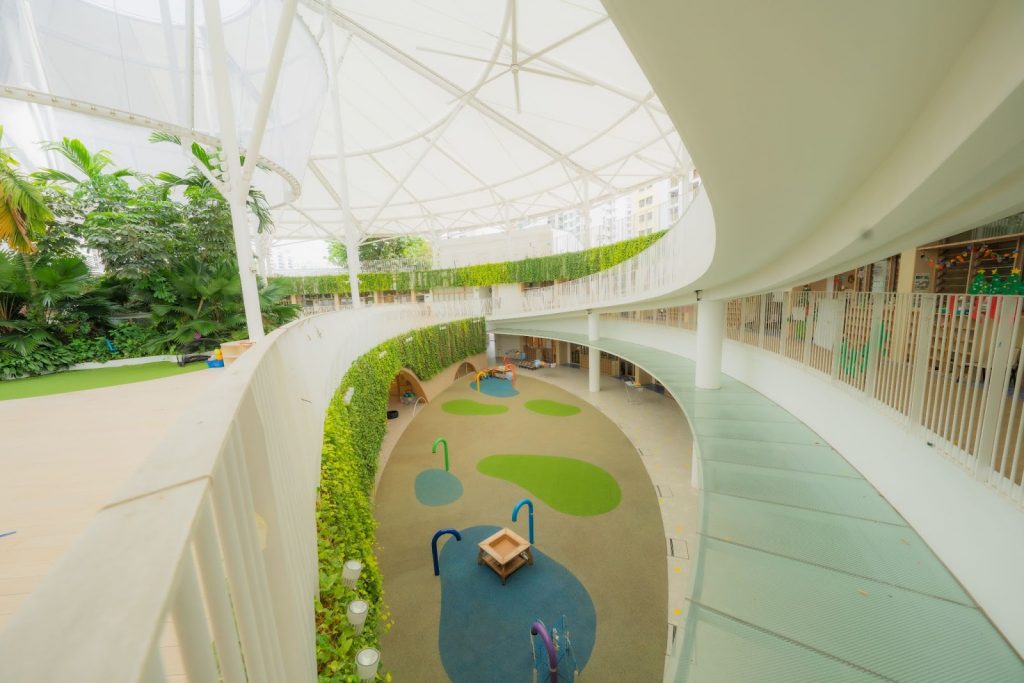
I’m no expert, but it’s probably never a good idea to house children in an environment that’s neither inspiring nor comfortable.
From what I recall of my preschool, there weren’t in-built outdoor play areas either. Instead, we’d borrow playgrounds from nearby neighbourhoods. Even teachers would regularly stress over the availability of these spots, as they might have already been taken over by other groups of children.
That meant that disappointment was a pretty common affair. Far too often did we excitedly head out to a playground only to discover that it was already occupied. Playtime felt like a territorial war.
On the contrary, the lucky kids here have in-built outdoor playgrounds (including swings and nets) that are housed on the rooftop. Not only are they readily accessible, but they also stand out from the usual plastic slides that we typically see.
“Again, it’s all about creating a different environment,” Tzu Yin says. “I’ve included materials like wood to add a touch of nature as plastic slides are more like fixed play and may come off as rather mechanical.”
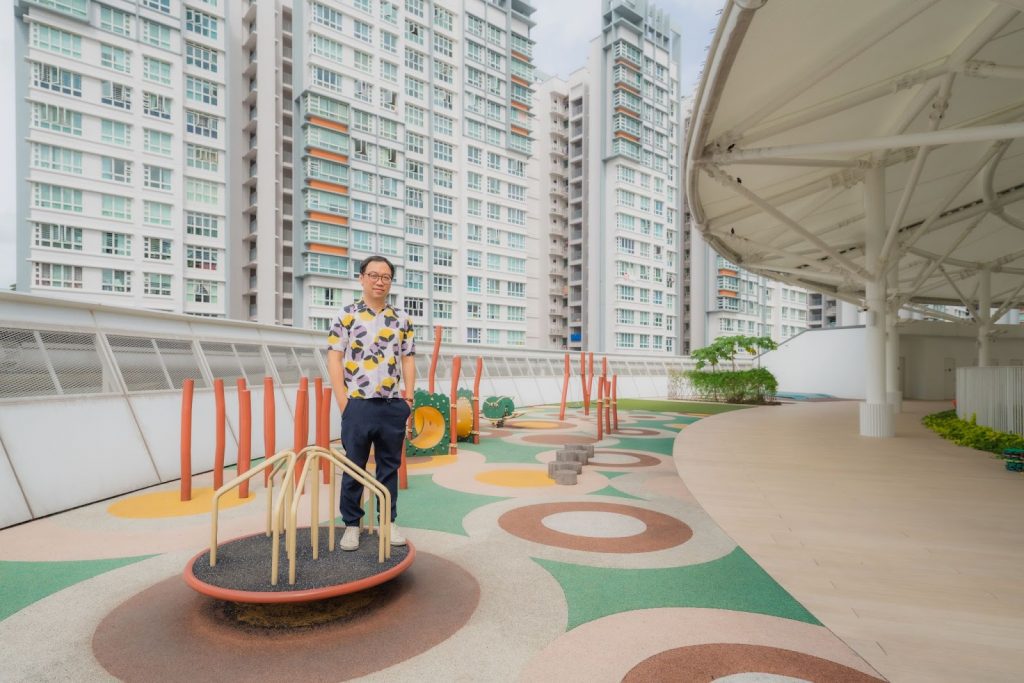
To what degree, then, does spatial design influence learning? I ask for Gilbert’s input as someone who overlooks the school’s operations on a daily basis.
Based on his personal observations, children at Sparkletots seem to pick up skills quicker — the presence of ramps as well as experiential and sensorial zones such as a water play area helps kids learn whilst they’re having fun.
“They’ll get ample opportunities to pick themselves up,” he says. “Or learn to crawl because the space complements their development.”

With the emergence of modern centres like these, could this be the solution to a stronger community spirit too? I most certainly hope so, as do Gilbert and Tzu Yin.
In pre-pandemic days, Gilbert shares that older children from various classes would get to play together on the rooftop’s playgrounds. The luxury of space gives them the opportunity to interact with schoolmates from different backgrounds, where they’d cycle their bikes in circles, or run wildly in the mini maze together.
Since children spend a significant portion of their day in school, learning mustn’t be confined to classrooms alone. On a typical day, these mini-humans would not only be attending classes; they’d also eat lunch, sing songs and interact under the towering trees and wide, open sky.

Kids aren’t the only ones who get to experience the beauty of unity here. In times of normalcy, the preschool also welcomes adults from the neighbouring community. Since 2018, they’ve hosted Chinese New Year dinners, karaoke sessions and even donation drives for low-income seniors who live in nearby rented flats.
“Preschool by day, party by night huh?” I joked.
Tzu Yin laughs; he’s immensely grateful that the space has been designed to be well-utilised to its maximum potential.

With so much design surrounding us in the world, we tend to take its impact for granted. When asked if he has any tips for aspiring architects, Tzu Yin hesitates to give a blanket statement, citing that every individual has different motivations in their process of creation.
There is one thing that he confidently advocates for though: “As architects, our goal has always been to impact communities and the way people live.”
“As long as you put people first, it shouldn’t go too wrong. I’m glad to have made a positive difference in some way or another, and will continue to do so.”
Sure enough, Gilbert affirms that parents have expressed how their children look happier and more confident since attending preschool. They’re friendlier to strangers; they’ve made genuine friends, and rarely do they cry or feel homesick. Much of this has been attributed to the warm ambience of the school.

As adults, we often get so caught up with the mundanity of life that we end up forgetting what it’s like to let our guard down or explore new things. As Antoine de Saint-Exupéry puts it in The Little Prince, “All grown-ups were once children, but only few of them remember it.”
My time at this preschool showed me that an inventive environment makes a world’s difference in sparking a sense of wonder and creativity. Take a moment to watch a young child play, and you’ll witness how creative innocence turns anything mundane into magical experiences. A hat is never only a hat in their eyes; it could be a boa constrictor!
At the heart of good design is a search for ways to create a better world. These little ones are armed with infinite imagination up their sleeves. It’s only fitting for the design of their schools to go beyond the ordinary too.

